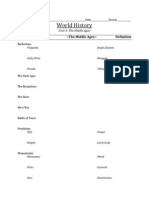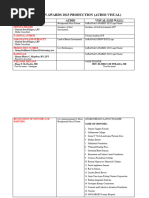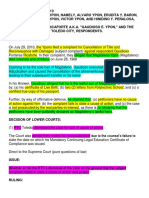0 ratings0% found this document useful (0 votes)
16 viewsDocumento 4
The document summarizes five notable events from the 13th century: 1) The Mongol Empire's expansion under Genghis Khan and Kublai Khan, including the establishment of the Yuan Dynasty in China; 2) The Fourth Crusade's sacking of Constantinople, weakening the Byzantine Empire; 3) The signing of the Magna Carta in England, establishing limits on royal power; 4) Advancements in Gothic architecture such as Paris' Notre-Dame Cathedral; 5) Venetian explorer Marco Polo's travels along the Silk Road and his documentation of Asia in "The Travels of Marco Polo".
Uploaded by
Agustin GarciaCopyright
© © All Rights Reserved
We take content rights seriously. If you suspect this is your content, claim it here.
Available Formats
Download as RTF, PDF, TXT or read online on Scribd
0 ratings0% found this document useful (0 votes)
16 viewsDocumento 4
The document summarizes five notable events from the 13th century: 1) The Mongol Empire's expansion under Genghis Khan and Kublai Khan, including the establishment of the Yuan Dynasty in China; 2) The Fourth Crusade's sacking of Constantinople, weakening the Byzantine Empire; 3) The signing of the Magna Carta in England, establishing limits on royal power; 4) Advancements in Gothic architecture such as Paris' Notre-Dame Cathedral; 5) Venetian explorer Marco Polo's travels along the Silk Road and his documentation of Asia in "The Travels of Marco Polo".
Uploaded by
Agustin GarciaCopyright
© © All Rights Reserved
We take content rights seriously. If you suspect this is your content, claim it here.
Available Formats
Download as RTF, PDF, TXT or read online on Scribd
You are on page 1/ 4
The 13th century was a time of profound historical
and cultural changes across different parts of the
world. Here are five notable moments from this
century:
Mongol Invasions and the Yuan Dynasty (Early 13th
Century):
The Mongol Empire, led by Genghis Khan and later
his descendants, expanded rapidly in the early 13th
century. Genghis Khan's successors, particularly
Kublai Khan, established the Yuan Dynasty in China
in 1271 after the conquest of the Southern Song
Dynasty. The Mongol Empire became the largest
contiguous land empire in history, influencing trade,
culture, and governance across Eurasia.
Fourth Crusade and the Sack of Constantinople
(1202–1204):
The Fourth Crusade, originally intended to
recapture Jerusalem, took an unexpected turn when
the crusaders sacked the Christian city of
Constantinople in 1204. This event had significant
consequences for the Byzantine Empire, weakening
its power and contributing to its eventual decline.
The sacking of Constantinople marked a
controversial chapter in the history of the Crusades.
Magna Carta (1215):
Signed by King John of England in 1215, the Magna
Carta is a foundational document in the
development of constitutional law and individual
rights. It was a response to the perceived abuses of
royal power and established the principle that the
king was not above the law. While initially focused
on the rights of the nobility, the Magna Carta laid
the groundwork for later constitutional
developments.
Gothic Architecture and Notre-Dame Cathedral
(Begun in 1163):
The 13th century witnessed the continuation and
refinement of Gothic architecture, with the
construction of iconic cathedrals such as Notre-
Dame in Paris. The innovative use of pointed arches,
ribbed vaults, and flying buttresses allowed for taller
and more intricate structures. Notre-Dame, begun
in the 12th century but largely completed in the
13th, remains a masterpiece of Gothic architecture.
Marco Polo's Travels (1271–1295):
Venetian explorer Marco Polo embarked on a
journey to the East in 1271, traveling along the Silk
Road and spending considerable time in the Mongol
Empire, China, and other regions. His accounts,
documented in "Il Milione" ("The Travels of Marco
Polo"), provided Europeans with detailed
information about the cultures, geography, and
riches of Asia. Polo's travels contributed to a greater
understanding of the East in medieval Europe.
These moments from the 13th century reflect the
diverse range of historical, cultural, and intellectual
developments that characterized this period in
different parts of the world.
You might also like
- The Rise and Fall of the Second Largest Empire in History: How Genghis Khan's Mongols Almost Conquered the WorldFrom EverandThe Rise and Fall of the Second Largest Empire in History: How Genghis Khan's Mongols Almost Conquered the World4/5 (1)
- The Dark Ages Collection: Chronicles of a Transformative EraFrom EverandThe Dark Ages Collection: Chronicles of a Transformative EraNo ratings yet
- The Dark Ages Collection: Epic Tales and Historical Writings from the Fall of Rome to the Dawn of the RenaissanceFrom EverandThe Dark Ages Collection: Epic Tales and Historical Writings from the Fall of Rome to the Dawn of the RenaissanceNo ratings yet
- The Renaissance: A Captivating Guide to a Remarkable Period in European History, Including Stories of People Such as Galileo Galilei, Michelangelo, Copernicus, Shakespeare, and Leonardo da VinciFrom EverandThe Renaissance: A Captivating Guide to a Remarkable Period in European History, Including Stories of People Such as Galileo Galilei, Michelangelo, Copernicus, Shakespeare, and Leonardo da VinciNo ratings yet
- Cross & Crescent in the Balkans: The Ottoman Conquest of Southeastern Europe (14th–15th centuries)From EverandCross & Crescent in the Balkans: The Ottoman Conquest of Southeastern Europe (14th–15th centuries)4/5 (1)
- The Great Events by Famous Historians, Volume 06 (From Barbarossa to Dante)From EverandThe Great Events by Famous Historians, Volume 06 (From Barbarossa to Dante)No ratings yet
- The Great Events by Famous Historians, Volume 08 The Later Renaissance: from Gutenberg to the ReformationFrom EverandThe Great Events by Famous Historians, Volume 08 The Later Renaissance: from Gutenberg to the ReformationNo ratings yet
- A History of the Later Roman Empire (Vol. 1&2): From the Death of Theodosius I to the Death of Justinian - German Conquest of Western Europe & the Age of JustinianFrom EverandA History of the Later Roman Empire (Vol. 1&2): From the Death of Theodosius I to the Death of Justinian - German Conquest of Western Europe & the Age of JustinianNo ratings yet
- Story of the Middle ages_ Timeline Checkpoint—1 to 31No ratings yetStory of the Middle ages_ Timeline Checkpoint—1 to 318 pages
- Middle ages 1st Edition Judy Galens instant download100% (1)Middle ages 1st Edition Judy Galens instant download56 pages
- PILA 07 HUM2020 Ch 7 - The Late Middle Ages100% (1)PILA 07 HUM2020 Ch 7 - The Late Middle Ages148 pages
- Adelman, Ch 11 Crisis and Recovery in Afro-EurasiaNo ratings yetAdelman, Ch 11 Crisis and Recovery in Afro-Eurasia4 pages
- NHSRCL Directory - For Website - EnglishNo ratings yetNHSRCL Directory - For Website - English2 pages
- OSC's Enforcement of The Anti-Gag Order Provision in Whistleblower LawNo ratings yetOSC's Enforcement of The Anti-Gag Order Provision in Whistleblower Law2 pages
- Graduated From The in 1954 With A Degree in The Field of ArchitectureNo ratings yetGraduated From The in 1954 With A Degree in The Field of Architecture3 pages
- In Re Argosino Bar Matter No. 712 July 13 1995 DigestNo ratings yetIn Re Argosino Bar Matter No. 712 July 13 1995 Digest1 page
- REV Santo Niño de Cebu Exhibit Outline and ConceptNo ratings yetREV Santo Niño de Cebu Exhibit Outline and Concept5 pages
- Women's Historical Declaration - Kanienkehaka (Mohawk) Traditional CouncilNo ratings yetWomen's Historical Declaration - Kanienkehaka (Mohawk) Traditional Council2 pages
- Office Memorandum Subject: Appointment of ConsultantsNo ratings yetOffice Memorandum Subject: Appointment of Consultants5 pages
- Enrollees: Nafa Talent Nafa Talent Development Development Programme Ay21/22 Programme Ay21/22 Enrollees EnrolleesNo ratings yetEnrollees: Nafa Talent Nafa Talent Development Development Programme Ay21/22 Programme Ay21/22 Enrollees Enrollees1 page
- Srs Law On Trade of Immovable Property 43/81: I Basic ProvisionsNo ratings yetSrs Law On Trade of Immovable Property 43/81: I Basic Provisions4 pages






























































































